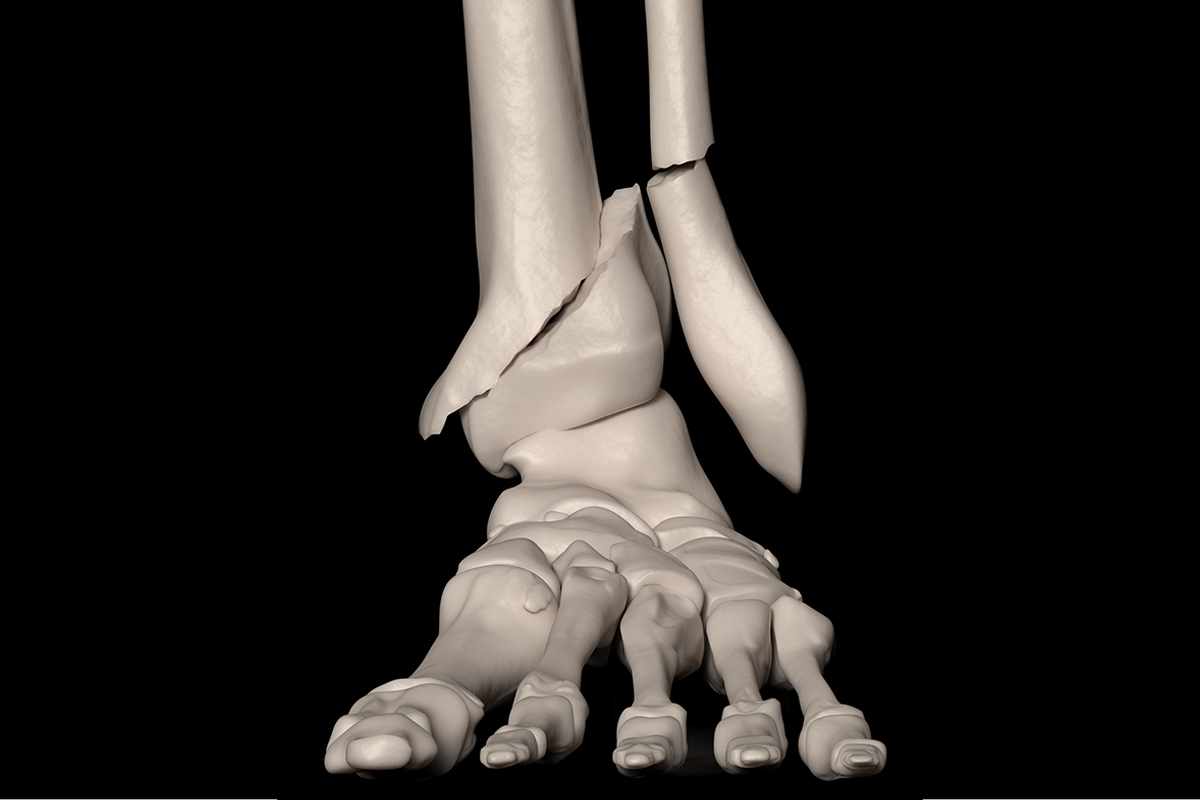A broken ankle or broken foot is a common injury that can significantly impact your mobility and daily activities. These injuries range from minor stress fractures to severe breaks involving multiple bones and joints. Prompt diagnosis and proper treatment are essential to ensure healing, prevent long-term complications, and restore function. Contact our office for your broken ankle treatment in San Francisco.
Broken Ankle and Broken Foot (foot and ankle fractures)
San Francisco

Broken Ankle (Ankle Fractures)
A broken ankle occurs when one or more bones in the ankle joint—the tibia, fibula, or talus—break due to trauma or twisting injuries. Common causes include falls, sports injuries, and car accidents. Symptoms typically include severe pain, swelling, bruising, and difficulty walking. Treatment varies based on the severity of the break. Minor breaks / fractures may heal with immobilization in a cast or boot, while more complex or displaced breaks often require surgery to realign and stabilize the bones using plates and screws. At Foot Surgery San Francisco, we utilize specialized surgical techniques, including minimally invasive approaches, to promote faster recovery and reduce scarring. My expertise in this area includes a comprehensive review on posterior malleolus fracture fixation published in Podiatry Today.
Broken Foot (Foot Fractures)
A broken foot can involve any of the bones in the foot, from the toes to the midfoot and heel. Depending on the location and severity of the break, symptoms may include pain, swelling, bruising, and difficulty bearing weight. Proper diagnosis and treatment are critical to prevent long-term complications like arthritis and chronic pain. Contact us for a personalized plan for broken foot treatment in San Francisco.

Talus and Heel Bone (Calcaneus) Fractures
A break in the talus or calcaneus, the bones forming the back of the foot and heel, typically result from high-energy injuries such as car accidents or falls from significant heights. These fractures can be severe and require specialized care to restore the shape and alignment of the bones.
- Non-surgical treatment: Immobilization with a cast or boot for less severe injuries.
- Surgical treatment: Internal fixation with plates and screws to realign the bones and promote healing.

Midfoot Fractures and Lisfranc Injuries
Broken foot / midfoot fractures, including Lisfranc injuries, involve the middle bones of the foot. They are often caused by twisting injuries or trauma, such as dropping a heavy object on the foot. These injuries can be subtle and are sometimes mistaken for sprains, making accurate diagnosis crucial. Early treatment is vital to prevent chronic pain and arthritis.
- Mild injuries may heal with casting and non-weight-bearing activity.
- Severe fractures or dislocations often require surgery to stabilize the bones and prevent long-term instability.
Broken Metatarsal (Metatarsal Fractures)
A broken metatarsal is one of the most common types of foot fractures. It often occurs due to direct trauma, repetitive stress, or twisting injuries. Symptoms include pain, swelling, and difficulty bearing weight. Many metatarsal fractures heal well with rest, immobilization, and activity modifications. However, more severe or displaced fractures may need surgery to ensure proper alignment and avoid complications. We offer advanced broken foot treatments in San Francisco by a top-rated podiatrist with compassion and care.

Jones Fracture (Broken fifth Metatarsal Bone)
Jones Fractures are a specific type of break in the fifth metatarsals, located on the outer side of the foot. These fractures are notorious for poor healing due to limited blood supply. Treatment may involve non-weight-bearing immobilization for less severe fractures. However, surgical fixation is often recommended to promote reliable healing and reduce the risk of re-injury. My expertise in both conservative and surgical treatments provides tailored care for each patient’s unique needs. With advanced techniques and minimally invasive approaches, I optimize recovery and outcomes for metatarsal fractures, including Jones fractures. My expertise in this area is demonstrated through my peer-reviewed publication on metatarsal fracture fixation in the Journal of Foot & Ankle Surgery.

Broken Toe (Toe Fractures)
Broken toes are common and often result from direct trauma, such as stubbing your toe or dropping an object on it. Symptoms include pain, swelling, and discoloration. Most broken toes can be managed with buddy taping and protective footwear. However, more complex fractures may require splinting or surgery if the joint is involved or if there is significant displacement.
Stress Fractures
Stress fractures are tiny cracks in the bones caused by repetitive stress and overuse. They commonly affect the metatarsals and other weight-bearing bones of the foot. Rest, activity modification, and protective footwear are typically effective for treating stress fractures. Severe cases may require immobilization or, rarely, surgical intervention to stabilize the bone.

Why Choose Us for Foot and Ankle Fracture Care
Dr. Nicole Cates at Foot Surgery San Francisco specializes in diagnosing and treating broken ankles, broken feet, and foot fractures with advanced surgical and non-surgical techniques. Dr. Nicole Cates at Foot Surgery San Francisco offers expert care for all types of broken bones of the foot and ankle, with advanced surgical and non-surgical techniques. With specialized training in trauma, sports medicine, deformity correction, and minimally invasive surgery, Dr. Cates provides personalized treatment plans that prioritize the best possible outcomes and a return to pain-free activity. If you have experienced a broken bone of foot or ankle, prompt evaluation and expert care are crucial for a successful recovery. Contact Foot Surgery today to schedule a consultation for your broken ankle treatment in San Francisco and take the first step toward regaining your mobility and health.

